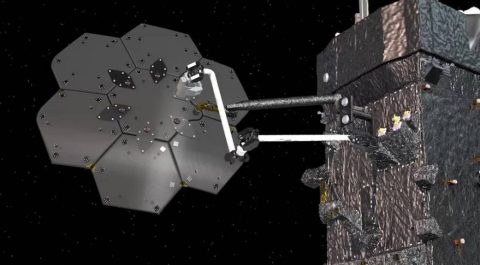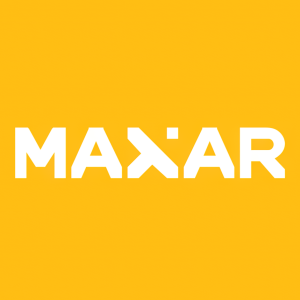Maxar Completes SPIDER Robotic Arm Critical Design Review
Maxar Technologies (NYSE:MAXR) (TSX:MAXR), a trusted partner and innovator in Earth Intelligence and Space Infrastructure, today announced that the SPace Infrastructure DExterous Robot (SPIDER) it is developing for NASA completed its Critical Design Review (CDR). SPIDER is a robotic assembly and manufacturing demonstration included on NASA’s upcoming On-Orbit Servicing, Assembly and Manufacturing-1 (OSAM-1) mission. With the CDR complete, Maxar remains on track to deliver the SPIDER hardware to NASA in the first half of 2022.

This SPIDER rendering shows the robotic arm assembling individual antenna reflector components into one large reflector. Image Credit: Maxar Technologies
SPIDER will demonstrate the ability to robotically assemble and reconfigure spacecraft components while on-orbit. This revolutionary process could allow satellites, telescopes and other systems to use larger and more powerful components that might not fit into a standard rocket fairing when fully assembled. SPIDER will be integrated with the spacecraft bus Maxar is also building for OSAM-1, which will refuel a government-owned satellite that was not originally designed to be serviced on-orbit. Specifically, for OSAM-1, SPIDER will assemble in space seven individual antenna reflector elements to construct one large, precisely shaped antenna reflector.
Maxar has previously delivered six robotic arms for NASA’s Mars rovers and landers, including the Sample Handling Assembly robotic arm on the recently landed Perseverance Rover.
The SPIDER CDR took place over a four-day period in February and demonstrated that the arm design meets NASA mission requirements. NASA missions undergo multiple rigorous technical and programmatic reviews as they proceed through the phases of development prior to launch. The CDR is one of several NASA mission milestones, culminating with the spacecraft’s launch.
“The innovative robotics technologies we are developing for SPIDER have the potential to enable an entirely new era of space infrastructure,” said Robert Curbeam, Maxar’s Senior Vice President of Space Capture. “SPIDER is one of many game-changing programs we have at Maxar. We hope to see this technology leveraged for a multitude of commercial and government space missions, including commercial satellite servicing, in-space telescope assembly and human exploration on the Moon and beyond under NASA’s Artemis program.”
As part of the OSAM-1 mission, SPIDER will also demonstrate in-space manufacturing using Tethers Unlimited’s MakerSat. MakerSat will manufacture a 10-meter lightweight composite beam, verifying its capability to form large spacecraft structures for future missions. As it manufactures the beam, MakerSat will measure the beam’s straightness and mechanical properties to determine if it is built to prescribed requirements.
Maxar first announced it was selected by NASA’s Space Technology Mission Directorate to perform an in-space assembly demonstration using a lightweight robotic arm in January 2020. Maxar is working in partnership with the West Virginia Robotic Technology Center on independent verification of SPIDER’s capabilities through multiple performance studies to increase the reliability of in-space assembly tasks.
About Maxar
Maxar is a trusted partner and innovator in Earth Intelligence and Space Infrastructure. We deliver disruptive value to government and commercial customers to help them monitor, understand and navigate our changing planet; deliver global broadband communications; and explore and advance the use of space. Our unique approach combines decades of deep mission understanding and a proven commercial and defense foundation to deploy solutions and deliver insights with unrivaled speed, scale and cost effectiveness. Maxar’s 4,300 team members in over 20 global locations are inspired to harness the potential of space to help our customers create a better world. Maxar trades on the New York Stock Exchange and Toronto Stock Exchange as MAXR. For more information, visit www.maxar.com.
Forward-Looking Statements
Certain statements and other information included in this release constitute "forward-looking information" or "forward-looking statements" (collectively, "forward-looking statements") under applicable securities laws. Statements including words such as "may", "will", "could", "should", "would", "plan", "potential", "intend", "anticipate", "believe", "estimate" or "expect" and other words, terms and phrases of similar meaning are often intended to identify forward-looking statements, although not all forward-looking statements contain these identifying words. Forward-looking statements involve estimates, expectations, projections, goals, forecasts, assumptions, risks and uncertainties, as well as other statements referring to or including forward-looking information included in this presentation.
Forward-looking statements are subject to various risks and uncertainties which could cause actual results to differ materially from the anticipated results or expectations expressed in this presentation. As a result, although management of the Company believes that the expectations and assumptions on which such forward-looking statements are based are reasonable, undue reliance should not be placed on the forward-looking statements because the Company can give no assurance that they will prove to be correct. The risks that could cause actual results to differ materially from current expectations include, but are not limited to, the risk factors and other disclosures about the Company and its business included in the Company's continuous disclosure materials filed from time to time with U.S. securities and Canadian regulatory authorities, which are available online under the Company's EDGAR profile at www.sec.gov, under the Company's SEDAR profile at www.sedar.com or on the Company's website at www.maxar.com.
The forward-looking statements contained in this release are expressly qualified in their entirety by the foregoing cautionary statements. All such forward-looking statements are based upon data available as of the date of this presentation or other specified date and speak only as of such date. The Company disclaims any intention or obligation to update or revise any forward-looking statements in this presentation as a result of new information or future events, except as may be required under applicable securities legislation.
View source version on businesswire.com: https://www.businesswire.com/news/home/20210310005292/en/








